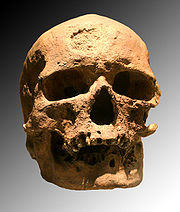
Abri de la Madeleine
Encyclopedia

Tursac
Tursac is a commune in the Dordogne department in Aquitaine in southwestern France. Abri de la Madeleine is the site of Magdalenian prehistoric finds.-Population:-External links:* *...
, in the Dordogne
Dordogne
Dordogne is a départment in south-west France. The départment is located in the region of Aquitaine, between the Loire valley and the High Pyrénées named after the great river Dordogne that runs through it...
département and the Aquitaine
Aquitaine
Aquitaine , archaic Guyenne/Guienne , is one of the 27 regions of France, in the south-western part of metropolitan France, along the Atlantic Ocean and the Pyrenees mountain range on the border with Spain. It comprises the 5 departments of Dordogne, :Lot et Garonne, :Pyrénées-Atlantiques, Landes...
Région of South-Western France. The Magdalenian
Magdalenian
The Magdalenian , refers to one of the later cultures of the Upper Paleolithic in western Europe, dating from around 17,000 BP to 9,000 BP...
culture of the Upper Paleolithic
Upper Paleolithic
The Upper Paleolithic is the third and last subdivision of the Paleolithic or Old Stone Age as it is understood in Europe, Africa and Asia. Very broadly it dates to between 40,000 and 10,000 years ago, roughly coinciding with the appearance of behavioral modernity and before the advent of...
is named after it, as the type site
Type site
In archaeology a type site is a site that is considered the model of a particular archaeological culture...
. Prehistoric finds from the site include the Bison Licking Insect Bite
Bison Licking Insect Bite
Bison Licking Insect Bite is a prehistoric carving by an unknown artist, created at Abri de la Madeleine near Tursac in Dordogne. Completed sometime between 20,000 and 12,000 BP, it currently resides in the Musee des Antiquites Nationales, St. Germain-en-Laye.It is carved and engraved on a fragment...
, a carving estimated 20,000 BC. On the top of the cliff just above the shelter is the medieval castle of Petit Marsac.
Excavations
Édouard LartetÉdouard Lartet
Édouard Lartet was a French paleontologist.-Biography:Lartet was born near Castelnau-Barbarens, of Gers, France, where his family had lived for more than five hundred years. He was educated for the law at Auch and Toulouse, but having private means elected to devote himself to science...
& Henry Christy
Henry Christy
Henry Christy was an English banker and collector who left his substantial collections to the British Museum.-Early life:...
were the first systematic excavators of the site, and published their findings in 1875 as the Age of the Reindeer ("L'âge du renne"). Finds from la madelaine are divided between a number of museums, including the Museum of Toulouse
Toulouse
Toulouse is a city in the Haute-Garonne department in southwestern FranceIt lies on the banks of the River Garonne, 590 km away from Paris and half-way between the Atlantic Ocean and the Mediterranean Sea...
, the Musee des Antiquites Nationales, St. Germain-en-Laye and the British Museum
British Museum
The British Museum is a museum of human history and culture in London. Its collections, which number more than seven million objects, are amongst the largest and most comprehensive in the world and originate from all continents, illustrating and documenting the story of human culture from its...
.
Further reading
- Laming-Emperaire, Annette. Origines de l'archéologie préhistorique en France, 1964.

